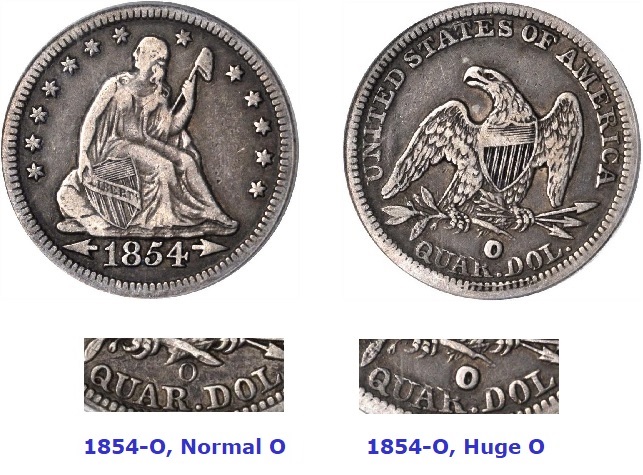1854-O Seated Liberty Quarter, Huge O
Normally, when we talk about the letter “O” in United States numismatics, it is a reference to the mintmark of the New Orleans Mint.
In the case of the intriguing Seated Liberty 1854-O “Huge O” variety, the “O” might stand for “Oddball” as well.
As was the practice in the 1850’s, all working dies were manufactured at the Philadelphia Mint. Dies prepared for transit to a branch mint received the applicable mintmark before being shipped out.(1)
Coin experts generally agree someone at the New Orleans Mint made a clumsy attempt to add an “O” to a single 1854 reverse die. The “homemade” mintmark is easily distinguishable to the naked eye because of its overly large and crude appearance. Furthermore, the left side is too thick, denying the mark of proper symmetry.
In an act of mercy, perhaps it is fair to say the individual responsible for this debasement lacked the proper tools and training to embark on such an endeavor.
The next question is why was the Huge O mintmark added? There are a couple of theories…
The most prevalent assumption is the Philadelphia Mint inadvertently sent a reverse die lacking the requisite “O” designation. The personnel at New Orleans addressed the oversight by adding the mintmark themselves, but in a sloppy manner.(2)
Another line of thought, one less frequented, is that the die initially arrived from Philadelphia with the “O” mintmark intact. When an inattentive Mint workman in New Orleans was preparing the die for re-use, he accidentally polished off the mintmark. Rather than leave bad enough alone, he hand-carved another “O”, this one oddly bigger and less professional than the original.(3)
No matter which theory is correct, one thing is certain: As an early step in the process of adding the “O,” excessive polishing occurred in the mintmark area, weakening the detail in the eagle’s right talon, the lowest arrow feather, the end of the branch stem, and the tops of the letters AR.D.(4)
Examples of the Huge O quarter display serious die cracking along the lower left border, an indication the die deteriorated rapidly after relatively few strikes, most likely because of the missteps taken to apply the makeshift mintmark.
There is little doubt the die failed prematurely and was withdrawn from service, explaining why there are so few examples of the 1854-O Huge O quarter. PCGS estimates there are only 350 survivors.(5)
The 1854-O Huge O quarter is a “Johnny-come-lately” in coin collecting. It wasn’t until the late 1970’s when the Huge O quarter started appearing in the “Redbook” and other price guides.
Since then, there have been multiple value trend cycles, but with prices ending higher than where they started every time. Right now, prices are taking a breather, suggesting there may now be bargains for the alert collector.
| Estimated survivors in all grades: 350 ?
The survivor estimate from PCGS represents an average of one or more experts' opinions as to how many examples survive of a particular coin in all grades. Survival estimates include coins that are raw, certified by PCGS, and certified by other grading services. Learn more at PCGS. |
| PCGS Rarity Scale: 6.3 ?
The 'PCGS CoinFacts Rarity Scale' assesses the relative rarity of all U.S. coins, based on estimated surviving examples. The scale runs from 1.0 to 10.0. The higher the number, the rarer the coin.
Learn more at PCGS. |
| Click HERE to check for availability on eBay** |
Preview of eBay selection:
 |
|
| Trendline Avg = 25.58 | BETTER |
Historic Value Trend Charts:
| Last updated 4-8-25 | Return to Key Date Coin List | |
| Compare to Common Date Coin of Same Type | ||
|
|
||
| Download Charts to Your Computer | ||
Sources
1. Stack's Bowers Galleries. 1854-O Liberty Seated Quarter. Huge O. Aug 2017 Auction.
2. Stack's Bowers Galleries. 1854-O Arrows. Huge O. Jan 2009 Auction.
3. Pilliod, Chris. "Mystery Solved". The Numismatist Magazine. American Numismatic Association, Aug 2007.
4. Stack's Bowers Galleries. 1854-O Liberty Seated Quarter. Huge O. Aug 2017 Auction.
5. PCGS. 1854-O 25C Huge O (Regular Strike).
**Many very fine coin dealers sell on eBay. At any point in time, there may be over one million search results for United States coins. This includes quite a few of the recommendations on our Key Date Coin List.
If you’re thinking about purchasing a rare coin, eBay is certainly worth a look. For your convenience, the links from this site to eBay are coded to bring up only coins certified by PCGS and NGC.
As is always, always the case, never buy a valuable coin from a seller whose trustworthiness cannot be verified. Learn more about this at our chapter Best Places to Buy Coins, which also has a section on doing business on eBay.
In the interest of full disclosure, Rare Coins 101 receives a small commission anytime someone connects to eBay from this site and purchases something.
Coin images by Stack's Bowers Galleries.


